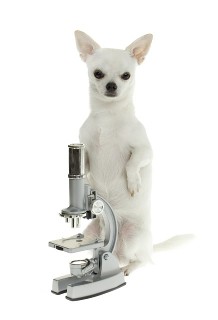Blood Work: CBC and Chemistry Panel
Adapted from : VP Client Information Sheets Authored by: Becky Lundgren, DVM
Veterinary Partner’s Pet Owner’s Info on Blood work
What does it mean when your veterinarian says she needs to run some blood work on your pet? Blood work and UA – pre-surgical or otherwise – is usually a combination of a complete blood count (CBC) and a blood chemical analysis, as well as urinalysis. Blood work is a basic evaluation tool. Ideally pets, particularly senior ones, should have a CBC and at least a mini chem panel at every annual examination. Blood work allows a veterinarian to monitor the progression of a pet’s disease, or diagnose diseases that are hidden in apparently healthy looking pets.
When the blood sample is drawn from your pet, both the cells and the fluid they “travel” in are examined.
The CBC – Complete Blood Count:
The cell part of the blood is examined in the CBC. The CBC determines the number of erythrocytes (red blood cells), the number and type of leukocytes (white blood cells), the number of platelets (thrombocytes), the hemoglobin level, and the hematocrit (packed cell volume, PCV). A CBC can tell your veterinarian if your pet has an unusual number of erythrocytes (anemia, polycythemia), leukocytes (leukopenia, leukocytosis), or platelets (thrombocytopenia).
- Red blood Cells carry oxygen throughout the body.
- The Hemoglobin level tells us how well the RBC’s carry the oxygen.
- The PCV tells how much blood is in the body compared to the fluid. This tells us about hydration and anemia.
- White blood cells fight infection and are part of the immune system. There are 5 different kinds, each doing a different job: neutrophils, lymphocytes, basophils, eosinophils, and monocytes.
- Platelets are clotting proteins and indicate how fast your pet’s blood can clot; slow clotting can be a serious problem.
The UA – Urinalysis:
While we sometimes think of it just for urinary tract infections, urine tests can provide diagnostic information about a number of diseases. The collection method is important for this test because it may depend on what disease is suspected. Urine can be caught in a cup during urination or by placing a needle directly into the bladder (cystocentesis, which isn’t as bad as it sounds), or even with a catheter.
 The chemistry panel (blood chem, chemistry screen):
The chemistry panel (blood chem, chemistry screen):
Tests kidney function, liver function, electrolyte levels, etc. Blood chemistries are run on the fluid in the blood sample. (The CBC is the examination of the cells in the blood sample.)
We have a complete set of laboratory machines right on site that can quickly test our most critical animals. Chemistries are usually available with in a half hour. We also uses a wide list of outside labs for additional testing when necessary. Our main outside lab is ANETCH DIAGNOSTICS
Antech Diagnostics – Blood Analysis and Testing
The chemistry panel usually includes the following tests: alkaline phosphatase (SAP, ALP), alanine transaminase (alanine aminotransferase, ALT), bilirubin total (T Bili), blood urea nitrogen (BUN), creatinine, creatine kinase (CK, CPK), sodium, potassium, glucose, total protein, albumin, etc. Alkaline phosphatase, alanine transaminase, bilirubin, and albumin give your veterinarian information about the pet’s liver function. Blood urea nitrogen, creatinine, and creatine kinase tell your veterinarian how well your pet’s kidneys are functioning.
 We also use many of the veterinary schools university labs all over the USA.
We also use many of the veterinary schools university labs all over the USA.
- Thyroid testing: TT4 and FT4 are often needed to determine if your pet has Hypothyroidism (which is especially common in overweight dogs or dogs with skin problems)or Hyperthyroidism (which is common in older cats).
- Cushings Testing: Cortisols, estrogens, testosterones are secreted by the adrenal glands. Many older dogs can show signs of Cushings disease or Atypical Cushings disease.
- Cholesterol: As it is in people, cholesterol is a fat. Unlike in people, it doesn’t contribute to heart disease in dogs and cats. Increased cholesterol is less common in cats than in dogs. Several diseases (diabetes, hypothyroidism, Cushing’s, or kidney disease) can elevate cholesterol levels.
- Bile Acids: While other liver tests are more for overall health of the liver, the Bile Acids Test is a liver function test. Many dogs may have normal liver blood chemistries but still have abnormal functioning livers. Bile acids help break down fat. Because these acids are produced in the liver, a bile acid test evaluates both the liver itself and the blood flow to it. Typically, bile acid tests are run pre-prandially (before eating), and post-prandially (two hours after eating).

